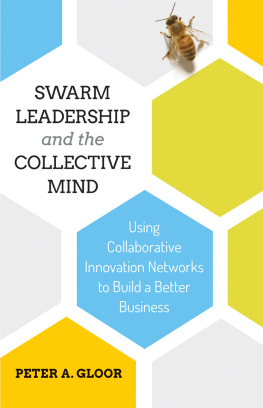Gloor - Swarm leadership and the collective mind: using collaborativeinnovation networks to build a better business
Here you can read online Gloor - Swarm leadership and the collective mind: using collaborativeinnovation networks to build a better business full text of the book (entire story) in english for free. Download pdf and epub, get meaning, cover and reviews about this ebook. City: Bingley;England, year: 2017, publisher: Emerald Publishing Limited, genre: Politics. Description of the work, (preface) as well as reviews are available. Best literature library LitArk.com created for fans of good reading and offers a wide selection of genres:
Romance novel
Science fiction
Adventure
Detective
Science
History
Home and family
Prose
Art
Politics
Computer
Non-fiction
Religion
Business
Children
Humor
Choose a favorite category and find really read worthwhile books. Enjoy immersion in the world of imagination, feel the emotions of the characters or learn something new for yourself, make an fascinating discovery.
Swarm leadership and the collective mind: using collaborativeinnovation networks to build a better business: summary, description and annotation
We offer to read an annotation, description, summary or preface (depends on what the author of the book "Swarm leadership and the collective mind: using collaborativeinnovation networks to build a better business" wrote himself). If you haven't found the necessary information about the book — write in the comments, we will try to find it.
Gloor: author's other books
Who wrote Swarm leadership and the collective mind: using collaborativeinnovation networks to build a better business? Find out the surname, the name of the author of the book and a list of all author's works by series.
Swarm leadership and the collective mind: using collaborativeinnovation networks to build a better business — read online for free the complete book (whole text) full work
Below is the text of the book, divided by pages. System saving the place of the last page read, allows you to conveniently read the book "Swarm leadership and the collective mind: using collaborativeinnovation networks to build a better business" online for free, without having to search again every time where you left off. Put a bookmark, and you can go to the page where you finished reading at any time.
Font size:
Interval:
Bookmark:
SWARM LEADERSHIP AND THE COLLECTIVE MIND
Using Collaborative Innovation Networks to Build a Better Business
SWARM LEADERSHIP AND THE COLLECTIVE MIND
Using Collaborative Innovation Networks to Build a Better Business
BY
PETER A. GLOOR
MIT Center for Collective Intelligence, Massachusetts Institute of Technology, Cambridge, MA, USA

United Kingdom North America Japan
India Malaysia China
Emerald Publishing Limited
Howard House, Wagon Lane, Bingley BD16 1WA, UK
First edition 2017
Copyright 2017 Peter A. Gloor
Reprints and permissions service
Contact:
British Library Cataloguing in Publication Data
A catalogue record for this book is available from the British Library
ISBN: 978-1-78714-201-5 (Print)
ISBN: 978-1-78714-200-8 (Online)
ISBN: 978-1-78714-726-3 (Epub)
 |  |
Isaac Newton famously said, If I see farther, it is only because I have been standing on the shoulders of giants. While I am by no means claiming to see as far ahead as Isaac Newton, I have definitively been standing on the shoulders of many giants.
First of all I would like to thank my children Sarah and David for many long discussions deep into the night, critically tearing apart and reassembling my ideas. My friend and colleague Hauke Fuehres has also been a constant critic and contributor of crucial ideas all along the way. In particular Hauke came up with the term homo collaborensis.
The members of my own COINs have been role models and inspiration for how to build the creative swarm. I am deeply indebted to Ken Riopelle and Julia Gluesing for reading early drafts and giving excellent feedback. Gianni Giacomelli, Vinit Verma, and George Dellal are all former industrial research sponsors who joined the COIN and commented on early versions of the manuscript. Andrea Fronzetti Colladon and Francesca Grippa are long-time academic collaborators, we have been jointly developing many of the ideas described in this book. Collaboration with Casper Lassenius, Maria Paasivaara, Cristobal Garcia, Christine Z. Miller, Takashi Iba, and Keiichi Nemoto goes back decades, they have been core members of our COIN significantly contributing to the concepts described here. Peter Margolis, Michael Seid, and George Dellal have been fearless leaders and role models of the C3N poster COIN described in this book, which greatly shaped my understanding of the inner workings of COINs.
Detlef Schoder, Kai Fischbach, Daniel Oster, Gloria Volkmann, Matthaeus P. Zylka, Oliver Posegga, Karin Frick, Detlef Guertler, Yang Song, Stephanie Woerner, Ornit Raz, Arlette Maurer, Daniel Olguin Olguin, and Ben Waber are all long-time collaborators and friends who contributed to projects described in the book.
Finally I am deeply indebted to Thomas W. Malone, Rob Laubacher, Alex (Sandy) Pentland, and Thomas J. Allen for being inspiring mentors and friends at MIT for the last 14 years.
CHAPTER CONTENTS
- Swarm leadership means listening first.
- Swarms practice competitive collaboration, not collaborative competition.
- The five-layer model of collaboration for individuals, organizations, and society.
Steve Jobs did not create Apple! Of course, Steve Jobs started Apple together with Steve Wozniak! But he did not create it. He could never have done it on his own. Steve Jobs created the swarm that created Apple. From the very first day on, he was relying on untold legions of engineers, scientists, technicians, accountants, and janitors not to speak of 4000 years of accumulated wisdom, and scientific and technological expertise accumulated from Chinese, Indian, Mesoamerican, Greek, Roman, German, English, French, and American philosophers, scientists, engineers, and entrepreneurs.
One human on its own is as useful as a single ant in creating the next Tesla, Apple, Google, or Facebook. However, just like the ants or the bees, a swarm of humans can do amazing things. And just like a swarm of ants or bees, the human swarm needs a queen bee, which is where Steve Jobs, Larry Page, Mark Zuckerberg, or Elon Musk comes in. The key, however, to their endeavor is communication! Only by communicating their goals, and channeling the accumulated energy and wisdom of their swarm can they set out to create the next big thing changing the world.
The goal of this book is to describe how to communicate to bring together groups of people to innovate. Better communication leads to better collaboration, which leads to more innovation. The information stored in a single neuron in the brain only becomes meaningful through the massively parallel network of connecting axons and synapses. This is no different for thousands of human brains, which can only work together to innovate by communicating with each other in the best possible way.
The future of business is swarm business whether its at Uber, Airbnb, Tesla, or Apple, its not about being a fearless leader, but about creating a swarm that works together in collective consciousness to create great things that change the world. This book helps you to become the leader of your own swarm by building its collective consciousness. A successful swarm channels the competitive energies of all stakeholders toward collaboration, demonstrated by exemplary swarm leaders such as Steve Jobs or Elon Musk, and exemplary swarm businesses such as Airbnb and Uber. The art is to select, grow, and nurture the right swarm. The overlooked secret of swarm businesses like Airbnb or Uber is not the genius of Uber and Airbnbs CEOs, but the pride all Airbnb landlords take in their apartments, and Uber drivers in their cars, forming a cohesive swarm delivering a superb experience to the customer.
This book takes you on a journey from homo competitivus to homo collaborensis. It explains how you as an individual, as a member of an organization, and as part of society can become more collaborative, and why this is good not just for society and the organization, but also for you. In a parallel to quantum physics, this book introduces social quantum physics, defining four key principles of social quantum physics: empathy leading to entanglement, and reflection leading to reboot and refocus. Collaborative organizations combine these four principles to build collective consciousness: deep empathy that builds an entangled team, and self-reflection that leads to constant self-criticism and refocus. Once the team is operational, its collaboration can be tracked and boosted using the six honest signals of collaboration, patterns of collaboration which will further increase the performance of the swarm. The six honest signals are central leadership, rotating leadership, balanced contribution, responsiveness, honest sentiment, and shared context. In their way of working together, team members apply the five ethical laws of collaboration: transparency, fairness, honesty, forgiveness, and listening. By operating according to these laws of collaborative ethics, such groups work together as collaborative teams, entangled in collective consciousness. Their journey starts with recruiting and building an intrinsically motivated group of early enthusiasts, the Collaborative Innovation Network (COIN). The fundamental concepts are illustrated with a wealth of examples from leading organizations based on decades of research by our team at MIT, ranging from Uber and Airbnb over open source communities to Fortune 500 high-tech firms and healthcare. These examples will tell you, as an individual, how becoming more collaborative will give more meaning and satisfaction to your professional life. They will also tell the managers of an organization how they can leverage their teams creative energies to increase organizational performance. And finally, they will lay out a way forward for society, toward a more collaborative and less competitive future.
Next pageFont size:
Interval:
Bookmark:
Similar books «Swarm leadership and the collective mind: using collaborativeinnovation networks to build a better business»
Look at similar books to Swarm leadership and the collective mind: using collaborativeinnovation networks to build a better business. We have selected literature similar in name and meaning in the hope of providing readers with more options to find new, interesting, not yet read works.
Discussion, reviews of the book Swarm leadership and the collective mind: using collaborativeinnovation networks to build a better business and just readers' own opinions. Leave your comments, write what you think about the work, its meaning or the main characters. Specify what exactly you liked and what you didn't like, and why you think so.











